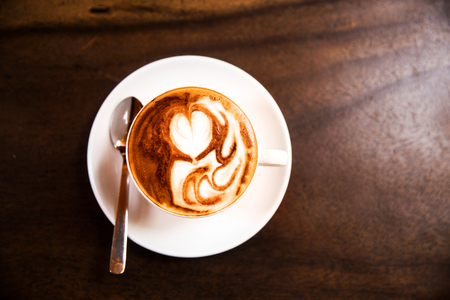Introduction to Latte Art and British Coffee Culture
If you stroll down the bustling streets of Soho or take a leisurely wander through Shoreditch, you’ll notice something beautifully consistent: the irresistible lure of independent cafés, each with its own artisan touch. Over the past decade, the UK has witnessed a true coffee renaissance, with latte art emerging as the signature flourish that sets apart a skilled barista from the rest. Far beyond just a pretty pattern atop your flat white, these intricate designs—whether a delicate rosetta, an elegant tulip, or a classic heart—are now seen as emblems of British café craftsmanship. From London’s creative quarters to cosy neighbourhood nooks in Bristol and Edinburgh, latte art has become part of Britain’s modern social tapestry, celebrated for both its aesthetic allure and the skill required to master it. In this step-by-step British guide, we’ll unpack how anyone can bring that same sense of artistry and café culture into their own home kitchen, with practical tips rooted in local style and sensibility.
2. Essential Tools and Ingredients for the Home Barista
If you’re keen to master latte art like a true Brit, it all starts with assembling the right kit and quality ingredients. Here’s your impeccably stylish guide to kitting out your home coffee station—British flair included.
The Must-Have Kit for British Home Baristas
| Equipment | Recommended UK Brands | Where to Buy |
|---|---|---|
| Espresso Machine | Sage, Gaggia, Dualit | John Lewis, Lakeland, Currys |
| Coffee Grinder (Burr) | Wilfa, Baratza, Sage | Harrods, Selfridges, Amazon UK |
| Milk Frothing Jug (Stainless Steel) | Motta, Rhino Coffee Gear | Coffee Hit, Whittard of Chelsea |
| Thermometer (Optional) | Heston Blumenthal by Salter | Argos, Robert Dyas |
| Tamper (Precision Tool) | Motta, Espro | Coffee Omega, Amazon UK |
Sourcing the Perfect Espresso Beans: The British Way
Your espresso is only as good as your beans. Look for freshly roasted options from top-notch UK roasters who prioritise ethical sourcing and flavour. Here are some beloved choices for coffee connoisseurs across the nation:
| Roaster | Location | Notes/Flavours |
|---|---|---|
| Square Mile Coffee Roasters | London | Berries, chocolatey undertones; a London staple. |
| Origin Coffee Roasters | Cornwall & London | Sustainably sourced; bright and lively profiles. |
| Workshop Coffee Co. | London & Online Nationwide Delivery | Clean, modern roasts—perfect for espresso. |
| Pact Coffee | UK-wide Delivery | Flexible subscriptions; always fresh. |
| Kiss the Hippo Coffee | Richmond & Fitzrovia, London/Online Delivery UK-wide | Organic and ethically sourced; punchy flavours. |
The Art of Milk: Choosing the Right Pour Partner
The milk you use can make or break your latte art. In Britain’s diverse café culture, semi-skimmed cow’s milk remains classic for its balance of creaminess and stretchability. However, plant-based alternatives have won hearts in homes from Manchester to Brighton. Here’s how they stack up:
| Milk Type | Best For Latte Art? | UK Favourite Brands |
|---|---|---|
| Semi-skimmed Cow’s Milk | Yes – reliable microfoam | Duchy Organic, Cravendale |
| Oat Milk (Barista Edition) | Yes – excellent stretch and neutral flavour | Oatly Barista, Minor Figures |
| Soy Milk (Barista Edition) | If formulated for baristas – decent foam | Alpro Barista, Bonsoy |
| Coconut or Almond Milk (Barista Edition) | Lighter foam but unique taste | Koko Barista, Rude Health |
A Note on Water Quality
A quintessentially British detail: use filtered water for brewing. London’s hard water can muddle flavours and damage your machine over time—so invest in a simple Brita filter jug or plumbed-in filter system if you’re serious about your daily cup.
Your Stylish Home Barista Setup Awaits
The tools and ingredients you choose are your passport to pouring picture-perfect Rosettas, Tulips and Hearts at home. With a nod to trusted British brands and a dash of personal taste, you’ll be sipping—and admiring—your own latte art creations in no time.

3. Perfecting the Espresso Shot: The British Way
Before you swirl your milk into artful shapes, every great cup begins with a properly pulled espresso shot—a ritual cherished from London’s artisan cafés to the cosiest corners of Edinburgh. Here’s your step-by-step guide to achieving that balanced, nuanced shot, all with a distinctly British sensibility.
Step 1: Choose Your Beans Wisely
Opt for freshly roasted beans sourced from reputable UK roasters—think Notes in London or Origin in Cornwall. The ideal roast should strike a balance between chocolatey warmth and subtle fruitiness, reflecting both tradition and the progressive tastes of Britain’s contemporary coffee scene.
Step 2: Mind the Grind
For home espresso, consistency is king. Invest in a burr grinder and aim for a fine, table-salt texture—too coarse and your shot will be weak; too fine and it’ll turn bitter. As Brits say, “Keep it just right.”
Step 3: Dose and Tamp Like a Pro
Dose approximately 18 grams for a double shot—a standard across most UK cafés. Distribute evenly in the portafilter and tamp firmly with a level hand, ensuring an even extraction (a nod to the precision found in classic English tea rituals).
Step 4: Pull the Shot
Brew at around 9 bars of pressure, aiming for a 25-30 second extraction. Watch as the crema forms—a rich golden layer that hints at quality. In true British fashion, patience is key; resist any urge to rush this stage.
Step 5: Taste and Adjust
Sip your espresso straight—no sugar just yet! A well-balanced shot should offer gentle acidity, rounded sweetness, and a clean finish. If it’s too sour or bitter, tweak your grind size or extraction time. Remember, practice makes perfect—just like mastering the art of pouring a proper cuppa.
With these foundational steps sorted, you’re well on your way to crafting exquisite Rosettas, Tulips, and Hearts—the sort that would make any British barista proud.
4. Mastering Milk Steaming for Silky Microfoam
To pour latte art that would impress even the most seasoned barista, getting your milk just right is essential. Most British kitchens are kitted out with either a stovetop milk pan, a French press, or – if you’re lucky – a home espresso machine with a steam wand. Let’s break down the process so you can achieve that glossy microfoam, perfect for Rosetta, Tulip, and Heart designs.
Choosing Your Kit
| Kit | Best For | Tips |
|---|---|---|
| Espresso Machine Steam Wand | Authentic microfoam | Purge steam before use; use cold, fresh milk |
| French Press | Manual frothing | Pump vigorously after heating milk on hob |
| Stovetop Milk Pan & Whisk | No specialist kit needed | Whisk briskly to create foam; don’t let milk boil |
The Art of Steaming and Frothing Milk
- Select Your Milk: Whole milk works best for silky texture, but oat or alternative milks can also shine.
- Temperature Matters: Aim for 60–65°C (140–149°F). Too hot and your milk will lose sweetness; too cold and it won’t integrate smoothly.
- Create Microfoam: If using a steam wand, submerge the tip just under the surface and angle your jug to spin the milk in a whirlpool motion. With a French press, pump up and down energetically until you see tight bubbles. For a pan and whisk, heat gently and whisk until glossy foam forms.
What Makes Glossy Microfoam?
- Tiny, uniform bubbles (no big frothy clouds)
- Smooth, shiny finish – like wet paint
- Pours easily and integrates with espresso for sharp patterns
Quick Troubleshooting Table
| Problem | Cause | Solution |
|---|---|---|
| Bubbles too large | Whisked too aggressively or wrong angle with steam wand | Adjust technique; focus on creating smaller bubbles at the start then swirl to integrate |
| Milk not glossy | Overheated or under-frothed milk | Aim for correct temperature; keep swirling till shiny |
Nail this step and you’re halfway to café-quality latte art at home. Once your microfoam is ready, you’re primed for pouring Rosetta, Tulip, and Heart masterpieces with unmistakable British flair.
5. Step-by-Step Pouring: Rosetta, Tulip, and Heart Techniques
Rosetta: The Classic Fern
Visualising the Rosetta
Start by holding your cup at a slight angle; imagine painting a fern along the surface. Begin your pour in the centre, keeping your jug low to encourage the milk to spread. Gently wiggle your hand back and forth as you move backwards, allowing the milk to create delicate leaves. As you approach the far edge of the cup, sweep the jug forward through the pattern for that signature stem. A right proper Rosetta looks impressive but is wonderfully achievable with a steady hand and a bit of patience.
Practical Hack
If your leaves are blending together, try slowing your wiggle and keeping your pour closer to the surface. Remember, even seasoned baristas have wobbly ferns from time to time!
Tulip: Layers of Elegance
Visualising the Tulip
For this motif, pour a small blob of milk into the centre – this forms your first ‘petal’. Pause, then add another small pour just above it, pushing slightly so it sits atop the first. Repeat two or three times for multiple layers. To finish, push through all layers with a gentle flick of the wrist. You’ll reveal a splendid tulip shape, blooming elegantly in your mug.
Practical Hack
British weather got you feeling slow? Let it inspire your technique – pause between each pour to give definition to each petal. There’s no rush; take it one layer at a time!
Heart: The Quintessential Symbol
Visualising the Heart
The heart is a beloved staple in British cafés. Hold your jug close to the surface and pour steadily into the centre. As a white circle forms, gently raise your jug and draw a thin line through it with a smooth pull. The result? A charming heart to brighten any rainy morning.
Practical Hack
If your heart ends up looking more like a potato (it happens!), simply call it “rustic charm” and enjoy every sip – after all, practice makes perfect.
Brew-tiful Encouragement
Remember: no one pours café art like Mary Berry bakes cakes on their first go! Every attempt adds character and skill. Stick the kettle on, try again, and soon you’ll be pouring patterns fit for afternoon tea with Her Majesty herself.
6. Troubleshooting Common Home Latte Art Woes
Even in the most stylish British kitchens, latte art can sometimes go awry. Don’t fret—most mishaps are easy to fix with a little know-how and a dash of patience. Here’s how to keep your pours picturesque, even when facing classic UK home challenges.
Chilly Kitchens: Battling the British Draught
Our famously brisk weather means kitchen temperatures can fluctuate, especially in older homes with less insulation. Cold mugs or milk cool too quickly, making it tricky to achieve that silky microfoam essential for latte art.
Tip: Warm your cups beforehand by swirling hot water in them. Always steam your milk fresh and pour immediately for best results.
Hard Water Havoc: Limescale Lurking
Many UK regions have hard water, leading to limescale buildup in kettles and espresso machines. This can affect both the taste of your coffee and the performance of your equipment.
Tip: Descale your machine regularly using a recommended solution. If possible, use filtered or bottled water for steaming milk and brewing espresso to prevent unwanted flavours and keep your kit in tip-top shape.
The Froth Fumble: Getting Your Milk Just Right
If your microfoam is bubbly or flat, you won’t get those crisp patterns. Remember, it’s all about achieving glossy, paint-like milk.
Tip: Use whole milk for creamier texture (or the best alternative if you’re dairy-free). Keep your steam wand just under the surface at first, then sink it deeper once you hear that gentle hissing sound—think subtlety, not a roaring train!
Poor Pour? Steady Hands Win
Nervous hands or wobbly wrists can turn hearts into blobs and tulips into puddles.
Tip: Take a breath, steady your hand, and pour slowly from higher up at first—then move closer as you begin to form your pattern.
The British Brew Bonus
If you’re still struggling, remember that even seasoned baristas needed practice. Embrace the process; each cup is an opportunity to perfect your Rosetta or tulip. And if all else fails—a sprinkle of cocoa or cinnamon always adds a touch of charm (and hides any wobbly lines)!
With these quintessentially British troubleshooting tips, your home latte art will be worthy of any café along the Thames—or tucked away in a cosy Cotswolds cottage.
7. Showcasing Your Latte Art: Share and Sip the British Way
Now that you’ve mastered the Rosetta, Tulip, and Heart pours at home, it’s time to share your artistry with a touch of British flair. Presentation is everything—consider serving your creations in classic bone china cups or vintage mugs for a truly British café feel. Place each cup on a saucer, add a delicate biscuit on the side, and perhaps a sprig of fresh mint for an elegant finish.
Hosting Your Own ‘Latte Art Off’
Why not invite your mates over for a friendly ‘latte art off’? Set up your kitchen as a cosy pop-up coffee bar: lay out some bunting, play a bit of Britpop or mellow jazz in the background, and have everyone take turns at the steam wand. Create scorecards for style, creativity, and taste—the winner gets bragging rights or perhaps a cheeky chocolate treat.
Sharing on Social Media—The British Way
Snap photos of your latte masterpieces in natural light (bonus points if you’ve got that soft London drizzle outside) and use quintessentially British hashtags like #BritBarista, #TeaAndCoffeeTime, or #HomeCafeUK. Don’t forget to caption with a dash of wit or understated charm—think “Not quite the Savoy, but my flat’s got heart.”
Keep It Sociable and Relaxed
Remember, the British approach is all about warmth and inclusion. Offer encouragement to first-timers, share tips over a slice of Victoria sponge, and celebrate even the wonkiest attempts. After all, it’s less about perfection and more about savouring good company—and great coffee—together.
By sharing your latte art with friends and family in this distinctly British way, you’ll not only showcase your new skills but also turn an ordinary cuppa into an occasion worth remembering.


